Lockheed UGM-27 Polaris
The Polaris was the first SLBM (Submarine-Launched Ballistic Missile) deployed by the U.S. Navy. Their inherent immunity to pre-emptive strikes has made SLBMs one of the most important assets of the U.S. nuclear armed forces ever since.
Like all U.S. military services, the U.S. Navy experimented with ballistic missiles in the immediate post-war years, mainly by using captured German A-4/V-2 rockets. However, it soon became clear that the hazard involved with liquid-propellant rockets ruled out this technology for shipboard use. In the early 1950s, solid-fuel rocket technology had advanced to a point where long-range missiles would be feasible. In 1955, however, the Navy was ordered to develop a derivative of the liquid-fueled SM-78/PGM-19 Jupiter IRBM as a sea-launched ballistic missile. In early 1956, the Navy was granted permission to develop a solid-fueled Jupiter derivative instead (to be called Jupiter S), and in December 1956, the Navy was finally allowed to drop out of the Jupiter program and develop a completely new solid-fueled ballistic missile. The new program was named Polaris, and development contracts were given to Lockheed (missile) and Aerojet (propulsion). From the beginning, Polaris was planned for launch from submarines. This made the missile effectively undetectable before launch, and had the additional advantage of providing a significantly more stable platform for an inertial navigation system, thereby increasing accuracy. Unlike other U.S. Navy missiles of the time, Polaris didn't receive a formal missile designation (like SSM-N-x or USM-N-x). Instead, the Polaris (and future SLBMs) were known by simple letter-number combinations, starting with A-1 (or A1, as the dash is frequently omitted) for the first Polaris version.
Polaris A-1 was significantly smaller and lighter than the proposed Jupiter S, allowing much more missiles to be carried by a submarine of a given size. Because starting a rocket motor inside a submarine was considered too dangerous, a so-called "cold launch" method was developed, where the missile is ejected from the vertical launch tube by gas pressure before the motor is ignited. The first launch of a Polaris AX test vehicle in September 1958 was unsuccessful, and the first fully successful flight only occurred in April 1959, after 5 other failures. In September 1959, the first Polaris A-1X tactical prototype missile, which included the inertial navigation system, was successfully launched, and tests of the A-1X continued through 1960. In the meantime, the Navy had built its first ballistic missile submarine, the USS George Washington (SSBN-598), by fitting an SSN under construction (SSN-589 Scorpion; name and hull number subsequently transferred to another boat) with a completely new center section with 16 missile launch tubes. The first successful underwater launch of a Polaris missile was accomplished by this ship on 20 July 1960, and in November 1960, the Polaris A-1 SLBM became operational on SSBN-598. On 6 May 1962, USS Ethan Allen (SSBN-608) successfully launched a Polaris A-1 with a live nuclear warhead in the United States' nuclear test range in the Pacific. This was the first and only full live test of a U.S. strategic missile.
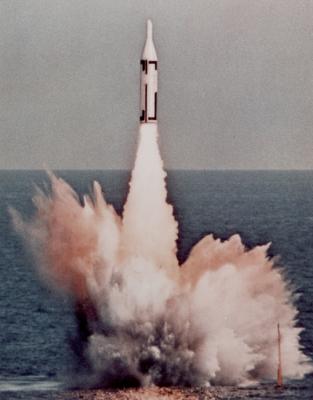 |
| Photo: Lockheed Martin Missiles & Space |
| UGM-27A |
The Polaris A-1 was powered by a two-stage solid-propellant rocket motor by Aerojet General, both stages using four nozzles with thrust-vectoring for flight control. Its inertial navigation system (designed by MIT, manufactured by General Electric and Hughes) guided the missile to an accuracy of about 900 m (3000 ft) CEP at a maximum range of 2200 km (1200 nm). This poor accuracy, coupled with a relatively low-yield W-47 (600 kT) thermonuclear warhead, made the Polaris unsuitable for strikes against hardened strategic targets. However, because the SLBM force could not effectively taken out by the enemy, it was the ideal retaliation weapon, and therefore very important for the Cold War concept of MAD (Mutually Assured Destruction).
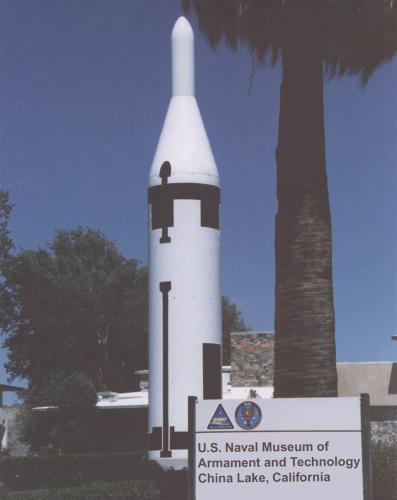 |
| Photo: U.S. Navy |
| UGM-27A |
Given the very short development time of Polaris (only four years from development contract to operational deployment), it is not surprising that the A-1 version had room for improvements. The Polaris A-2 had a slightly longer first stage, using the full length of the missile tubes, and a lighter second-stage motor casing made of fiberglass instead of steel. These features increased range to 2800 km (1500 nm), the performance originally envisioned by the Navy. The A-2 also had new electronics for higher reliability. The first A-2 was launched in November 1960, and deployment of this version began in June 1962.
The Polaris A-3 was a significantly enhanced missile with all the extensive changes, which weren't incorporated in the A-1/2 because of the very short development time frame. The A-3 saved weight by using fiberglass casings for both stages, and a 60% lighter guidance section. The second stage used a completely new motor by Hercules, with a high-energy propellant and a single nozzle with fluid-injection thrust-vectoring control. These features increased range to 4600 km (2500 nm). The A-3 also had a completely new warhead section with three reentry vehicles, each carrying a 200 kT W-58 warhead. The inertial navigation system was also gradually improved, leading to an accuracy of about 600 m (2000 ft) CEP. The first (partially successful) test of a Polaris A-3 occurred in August 1962, and testing continued through 1964. The A-3 became operational in September 1964 aboard USS Daniel Webster (SSBN-626).
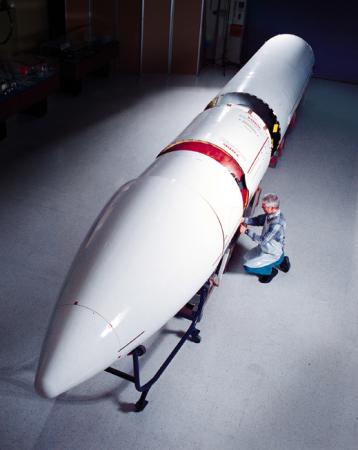 |
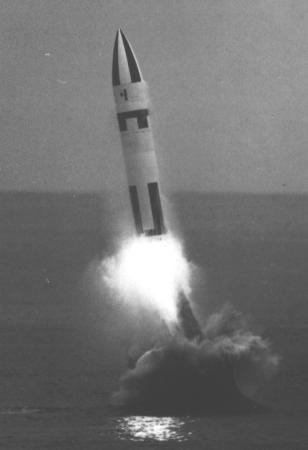 | |
| Photo: Lockheed Martin Missiles & Space | Photo: U.S. Navy | |
| UGM-27C | ||
In June 1963, all Polaris missiles were designated in the UGM-27 series as follows:
| SLBM Designation | New Designation |
|---|---|
| A-1 | UGM-27A |
| A-2 | UGM-27B |
| A-3 | UGM-27C |
The UGM-27C eventually replaced all earlier UGM-27A/B missiles, and by 1974, only the Polaris A-3 was still in service. By that time, however, some A-3s had already been replaced by the new UGM-73 Poseidon C-3 SLBM. The final Polaris A-3 was withdrawn from service in October 1981. Between 1959 and 1968, Lockheed had produced about 1150 Polaris missiles of all versions, the majority (640+) being UGM-27Cs.
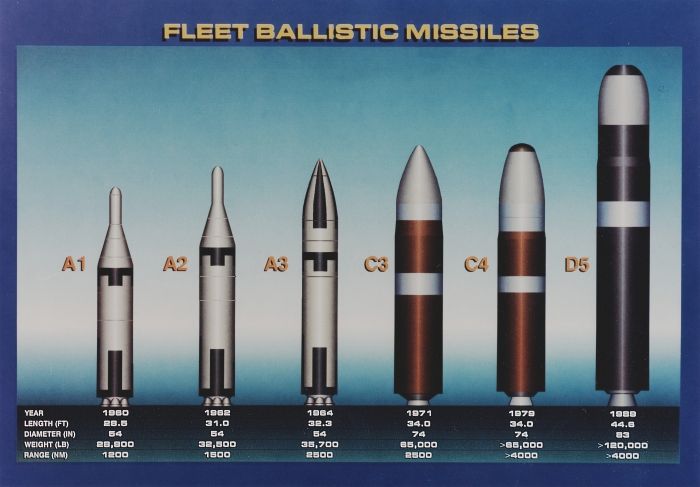 |
| Image: Lockheed Martin Missiles & Space |
| SLBM family: UGM-27A, UGM-27A, UGM-27C, UGM-73A, UGM-96A, UGM-133A |
Specifications
Note: Data given by several sources show slight variations. Figures given below may therefore be inaccurate!
Data for UGM-27A/B/C:
| UGM-27A | UGM-27B | UGM-27C | |
|---|---|---|---|
| Length | 8.69 m (28 ft 6 in) | 9.45 m (31 ft) | 9.86 m (32 ft 4 in) |
| Diameter | 1.37 m (4 ft 6 in) | ||
| Weight | 13000 kg (28800 lb) | 14700 kg (32500 lb) | 16200 kg (35700 lb) |
| Speed | 12900 km/h (8000 mph) | ||
| Ceiling | 640 km (400 miles) | 800 km (500 miles) | |
| Range | 2200 km (1200 nm) | 2800 km (1500 nm) | 4600 km (2500 nm) |
| Propulsion | 1st stage: Aerojet General solid-fueled rocket 2nd stage: Aerojet General solid-fueled rocket |
1st stage: Aerojet General solid-fueled rocket 2nd stage: Hercules X-260 solid-fueled rocket | |
| Warhead | W-47 thermonuclear (600 kT) | 3x W-58 thermonuclear (200 kT) in 3x MK 2 RV | |
Main Sources
[1] James N. Gibson: "Nuclear Weapons of the United States", Schiffer Publishing Ltd, 1996
[2] Norman Friedman: "US Naval Weapons", Conway Maritime Press, 1983
[3] Bill Gunston: "The Illustrated Encyclopedia of Rockets and Missiles", Salamander Books Ltd, 1979
[4] René J. Francillon: "Lockheed Aircraft since 1913", Putnam, 1987
Back to Current Designations Of U.S. Unmanned Military Aerospace Vehicles
Back to Directory of U.S. Military Rockets and Missiles
Last Updated: 17 May 2007